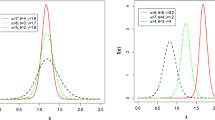Abstract
The presence of immune elements (generating a fraction of cure) in survival data is common. These cases are usually modeled by the standard mixture model. Here, we use an alternative approach based on defective distributions. Defective distributions are characterized by having density functions that integrate to values less than \(1\), when the domain of their parameters is different from the usual one. We use the Marshall–Olkin class of distributions to generalize two existing defective distributions, therefore generating two new defective distributions. We illustrate the distributions using three real data sets.














Similar content being viewed by others
References
Aalen O, Borgan O, Gjessing H (2008) Survival and event history analysis: a process point of view. Springer, New York
Aalen OO, Gjessing HK (2001) Understanding the shape of the hazard rate: a process point of view (with comments and a rejoinder by the authors). Stat Sci 16(1):1–22
Alice T, Jose KK (2003) Marshall–Olkin pareto processes. Far East J Theor Stat 9(2):117–132
Alice T, Jose KK (2005) Marshall–Olkin logistic processes. STARS Int J 6:1–11
Balka J, Desmond AF, McNicholas PD (2009) Review and implementation of cure models based on first hitting times for wiener processes. Lifetime Data Anal 15(2):147–176
Balka J, Desmond AF, McNicholas PD (2011) Bayesian and likelihood inference for cure rates based on defective inverse gaussian regression models. J Appl Stat 38(1):127–144
Barreto-Souza W, Lemonte AJ, Cordeiro GM (2013) General results for the marshall and olkin’s family of distributions. Anais da Academia Brasileira de Ciências 85(1):3–21
Berkson J, Gage RP (1952) Survival curve for cancer patients following treatment. J Am Stat Assoc 47(259):501–515
Boag JW (1949) Maximum likelihood estimates of the proportion of patients cured by cancer therapy. J R Stat Soc Ser B (Methodol) 11(1):15–53
Cantor AB, Shuster JJ (1992) Parametric versus non-parametric methods for estimating cure rates based on censored survival data. Stat Med 11(7):931–937
Chen MH, Ibrahim JG, Sinha D (1999) A new bayesian model for survival data with a surviving fraction. J Am Stat Assoc 94(447):909–919
Cordeiro GM, Lemonte AJ (2013) On the Marshall–Olkin extended weibull distribution. Stat Papers 54(2):333–353
Gieser PW, Chang MN, Rao PV, Shuster JJ, Pullen J (1998) Modelling cure rates using the gompertz model with covariate information. Stat Med 17(8):831–839
Haybittle JL (1959) The estimation of the proportion of patients cured after treatment for cancer of the breast. Br J Radiol 32(383):725–733
Ibrahim JG, Chen MH, Sinha D (2005) Bayesian survival analysis. Wiley Online Library, New York
Jose KK, Krishna E (2011) Marshall–Olkin extended uniform distribution. Probab Stat Optim 4:78–88
Kersey JH, Weisdorf D, Nesbit ME, LeBien TW, Woods WG, McGlave PB, Kim T, Vallera DA, Goldman AI, Bostrom B (1987) Comparison of autologous and allogeneic bone marrow transplantation for treatment of high-risk refractory acute lymphoblastic leukemia. N Engl J Med 317(8):461–467
Klein JP, Moeschberger ML (2003) Survival analysis: statistical methods for censored and truncated data. Springer, New York
Laurie JA, Moertel CG, Fleming TR, Wieand HS, Leigh JE, Rubin J, McCormack GW, Gerstner JB, Krook JE, Malliard J (1989) Surgical adjuvant therapy of large-bowel carcinoma: an evaluation of levamisole and the combination of levamisole and fluorouracil. the north central cancer treatment group and the mayo clinic. J Clin Oncol 7(10):1447–1456
Lee MLT, Whitmore GA (2004) First hitting time models for lifetime data. Handb Stat 23:537–543
Lee MLT, Whitmore GA (2006) Threshold regression for survival analysis: modeling event times by a stochastic process reaching a boundary. Stat Sci 21(4):501–513
Marshall AW, Olkin I (1997) A new method for adding a parameter to a family of distributions with application to the exponential and weibull families. Biometrika 84(3):641–652
R Core Team (2014) R: a language and environment for statistical computing. R Foundation for Statistical Computing, Vienna, Austria. http://www.R-project.org/
Schrödinger E (1915) Zur theorie der fall-und steigversuche an teilchen mit brownscher bewegung. Phys Z 16:289–295
Tweedie MCK (1945) Inverse statistical variates. Nature 155(3937):453–453
Whitmore GA (1979) An inverse gaussian model for labour turnover. J R Stat Soc Ser A (Gener) 142(4):468–478
Whitmore GA, Crowder MJ, Lawless JF (1998) Failure inference from a marker process based on a bivariate wiener model. Lifetime Data Anal 4(3):229–251
Yakovlev AY, Tsodikov AD (1996) Stochastic models of tumor latency and their biostatistical applications, vol 1. World Scientific, Singapore
Acknowledgments
The authors thank the Conselho Nacional de Desenvolvimento Científico e Tecnológico (CNPq/Brazil) for financial support during the course of this project. The authors also thank the Associate Editor and the two referees for carefully reading and for comments which greatly improved the paper.
Author information
Authors and Affiliations
Corresponding author
Rights and permissions
About this article
Cite this article
Rocha, R., Nadarajah, S., Tomazella, V. et al. Two new defective distributions based on the Marshall–Olkin extension. Lifetime Data Anal 22, 216–240 (2016). https://doi.org/10.1007/s10985-015-9328-x
Received:
Accepted:
Published:
Issue Date:
DOI: https://doi.org/10.1007/s10985-015-9328-x



